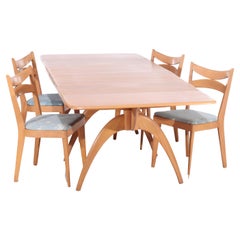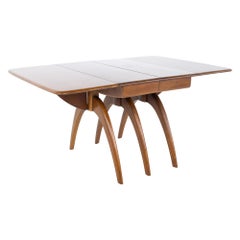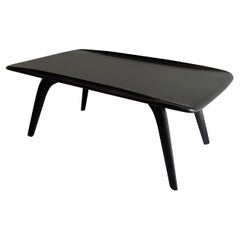Heywood Wakefield Wishbone Table
Vintage Heywood Wakefield Champagne Finish Birch Wishbone Drop Leaf Table C1950
By Heywood-Wakefield Co.
Located in Big Flats, NY
Wakefield Champagne Finish Birch Wishbone Drop Leaf Table with Two Leaves & Four Chairs Signed C1950
Category
20th Century Drop-leaf and Pembroke Tables
Materials
Birch
$2,360 Sale Price / set
20% Off
H 94.25 in W 40 in D 29 in
Recent Sales
Heywood Wakefield Mid Century Wishbone Dining Table
By Heywood-Wakefield Co.
Located in Franklin Park, IL
Heywood Wakefield mid century wishbone dining table.
Table measures: 58 wide x 40 deep x 29 inches
Category
Vintage 1970s American Mid-Century Modern Dining Room Tables
Materials
Wood
Ebonized Maple Heywood Wakefield Wishbone Coffee Table
By Heywood-Wakefield Co.
Located in Brooklyn, NY
Compact, Mid-Century Modern, solid maple, coffee table features "wishbone" legs and upturned sides
Category
Mid-20th Century American Mid-Century Modern Coffee and Cocktail Tables
Materials
Maple
Heywood-Wakefield Butterfly Drop-Leaf Wishbone Dining Table
By Heywood-Wakefield Co.
Located in Van Nuys, CA
This original solid maple "Butterfly" dining table by Heywood-Wakefield circa 1948 features an
Category
Vintage 1940s American Dining Room Tables
Materials
Steel
Heywood-Wakefield Mid-Century Modern Wishbone Coffee Table
By Heywood-Wakefield Co.
Located in South Bend, IN
Offering an excellent original condition Heywood-Wakefield coffee table. The table has iconic
Category
Vintage 1950s Mid-Century Modern Coffee and Cocktail Tables
Heywood Wakefield Mid-Century Modern Extension Wishbone Dining Table
By Heywood-Wakefield Co.
Located in South Bend, IN
An exceptional Mid-Century Modern extension drop-leaf wishbone dining table by Heywood-Wakefield
Category
Vintage 1950s American Mid-Century Modern Dining Room Tables
Materials
Maple
Heywood Wakefield Mid-Century Modern Extension Wishbone Dining Table
By Heywood-Wakefield Co.
Located in South Bend, IN
An exceptional Mid-Century Modern extension drop-leaf wishbone dining table by Heywood-Wakefield
Category
Vintage 1950s American Mid-Century Modern Dining Room Tables
Materials
Maple
Mid-Century Modern Heywood Wakefield Wishbone Side Table, Circa 1950
By Heywood-Wakefield Co.
Located in Big Flats, NY
A Mid-Century Modern side table by Heywood Wakefield offers birch construction in Wishbone form
Category
Mid-20th Century American Mid-Century Modern Side Tables
Materials
Birch
H 25.25 in W 21.25 in D 21.25 in
Heywood Wakefield Mid-Century Modern Maple Wishbone Dining Table, Refinished
By Heywood-Wakefield Co.
Located in South Bend, IN
table
By Heywood Wakefield
USA, 1950s
Measures: 94.63" W x 40" D x 29" H. (fully extended with
Category
Vintage 1950s American Mid-Century Modern Dining Room Tables
Materials
Maple
H 29 in W 94.63 in D 40 in
Mid 20th Century Heywood-Wakefield Mid Century Modern Wishbone Corner Table
By Heywood-Wakefield Co.
Located in Los Angeles, CA
Vintage Heywood Wakefield wishbone two-step corner table constructed of solid birch with convex
Category
Vintage 1950s North American Mid-Century Modern Sofa Tables
Materials
Birch
Classic Mid Century Heywood-Wakefield Butterfly Drop-Leaf Wishbone Dining Table
By Heywood-Wakefield Co.
Located in Buffalo, NY
Classic mid century Heywood-Wakefield butterfly drop-leaf wishbone dining table in beautiful "wheat
Category
Vintage 1950s American Mid-Century Modern Dining Room Tables
Materials
Birch
H 29 in W 76 in L 29 in
Heywood Wakefield Mid-Century Modern Solid Maple Wishbone Dining Table, 1950s
By Heywood-Wakefield Co.
Located in South Bend, IN
table
By Heywood Wakefield
USA, 1950s
Measures: 58" W x 40" D x 29" H. Extends up to 94" W with
Category
Vintage 1950s American Mid-Century Modern Dining Room Tables
Materials
Maple
H 29 in W 94 in L 29 in
Heywood Wakefield Mid-Century Modern Solid Maple Wishbone Extension Dining Table
By Heywood-Wakefield Co.
Located in South Bend, IN
Heywood Wakefield
USA, 1950s
Solid sculpted maple, in original "wheat" finish.
Measures: 28" W x
Category
Vintage 1950s American Mid-Century Modern Dining Room Tables
Materials
Maple
H 29 in W 94.5 in D 40 in
Heywood Wakefield Mid-Century Modern Wishbone Lazy Susan Round Coffee Table
By Heywood-Wakefield Co.
Located in South Bend, IN
Offering a very nice Heywood-Wakefield Lazy Susan round coffee table. The table has nice wishbone
Category
Vintage 1950s Mid-Century Modern Coffee and Cocktail Tables
Materials
Birch
H 15.5 in W 32 in D 32 in
Mid-Century Modern Heywood Wakefield "Butterfly" Wishbone Drop-Leaf Dining Table
By Heywood-Wakefield Co.
Located in Wilmington, DE
This is a drop-leaf table with two extension boards and a champagne finish. It is made from solid
Category
Vintage 1950s American Mid-Century Modern Dining Room Tables
Materials
Birch
H 29 in W 40 in D 95 in
Heywood Wakefield Butterfly Drop Leaf Wishbone Dining Table with 2 Leaves
By Heywood-Wakefield Co.
Located in Philadelphia, PA
Heywood Wakefield butterfly drop leaf wishbone dining table with 2 leaves. Item features (2) 18
Category
Vintage 1950s North American Mid-Century Modern Drop-leaf and Pembroke T...
Materials
Maple
Heywood Wakefield Ebonized Wishbone Dogbone Dining Room Set For Eight
By Heywood-Wakefield Co.
Located in Brooklyn, NY
chairs by Heywood Wakefield. The drop-leaf, extension, dining table expands from a compact 26 inches with
Category
Mid-20th Century American Mid-Century Modern Dining Room Sets
Materials
Maple
Mid Century Modern Heywood Wakefield Wishbone Dining Room Set with Four Chairs
By Heywood-Wakefield Co.
Located in Big Flats, NY
Modern Heywood Wakefield Wishbone Dining Room Set with Four Chairs & Two Leaves C1950.
Measures
Category
Mid-20th Century Mid-Century Modern Dining Room Sets
Materials
Birch
H 28.5 in W 38 in D 78.5 in
Heywood Wakefield Mid Century Maple Wishbone Expanding Dining Table
By Heywood Brothers & Co.
Located in Franklin Park, IL
Heywood Wakefield mid century maple wishbone expanding dining table
This table measures 58 wide x
Category
Vintage 1970s American Mid-Century Modern Dining Room Tables
Materials
Maple
Vintage MCM Heywood Wakefield Wishbone Dining Table
By Heywood-Wakefield Co.
Located in West Palm Beach, FL
Fantastic vintage MCM dining table. Made by the iconic Heywood Wakefield. The coveted Wishbone
Category
Mid-20th Century North American Mid-Century Modern Dining Room Tables
Materials
Maple
Heywood-Wakefield Butterfly Drop-Leaf Wishbone Dining Table
By Heywood-Wakefield Co.
Located in Van Nuys, CA
This original solid maple "Butterfly" dining table by Heywood-Wakefield circa 1948 features a
Category
Vintage 1940s American Tables
Materials
Steel
Heywood-Wakefield Mid-Century Modern Extension Wishbone Dining Table
By Heywood-Wakefield Co.
Located in South Bend, IN
An exceptional Mid-Century Modern extension drop-leaf wishbone dining table by Heywood-Wakefield
Category
Vintage 1950s American Mid-Century Modern Dining Room Tables
Materials
Maple
Heywood Wakefield Mid-Century Modern Extension Wishbone Dining Table
By Heywood-Wakefield Co.
Located in South Bend, IN
A gorgeous Mid-Century Modern extension drop-leaf wishbone dining table by Heywood-Wakefield. The
Category
Vintage 1950s American Mid-Century Modern Dining Room Tables
Materials
Maple
Mid-Century Modern Heywood Wakefield Wishbone Corner Table, Wheat, Circa 1950
By Heywood-Wakefield Co.
Located in Big Flats, NY
A Mid-Century Modern Heywood Wakefield corner side stand in the Wishbone pattern offers birch
Category
Mid-20th Century American Mid-Century Modern Tables
Materials
Wood
H 24 in W 32 in D 32 in
Heywood Wakefield Midcentury Wishbone Expanding Dining Table with 2 Leaves
By Heywood-Wakefield Co.
Located in Franklin Park, IL
Heywood Wakefield midcentury wishbone expanding dining table with 2 leaves.
This table measures
Category
Vintage 1970s American Mid-Century Modern Dining Room Tables
Materials
Wood
H 28.75 in W 94 in D 40 in
Heywood Wakefield Mid Century Wishbone Dining Table with 2 Leaves
By Heywood-Wakefield Co.
Located in Franklin Park, IL
Heywood Wakefield Mid Century wishbone dining table with 2 leaves
This table measures: 27.5 wide
Category
Vintage 1970s American Mid-Century Modern Dining Room Tables
Materials
Wood
Heywood Wakefield Mid-Century Modern Solid Maple Wishbone Dining Table, 1950s
By Heywood-Wakefield Co.
Located in South Bend, IN
table
By Heywood Wakefield
USA, 1950s
Measures: 58" W x 40" D x 29" H. Extends up to 94" W with
Category
Vintage 1950s American Mid-Century Modern Dining Room Tables
Materials
Maple
H 29 in W 94 in D 40 in
Mid-Century Modern Wishbone Dining Table Set by Heywood Wakefield, 20th Century
By Heywood-Wakefield Co.
Located in Big Flats, NY
Mid-Century Modern Wishbone dining table and chairs by Heywood Wakefield features triple pedestal
Category
20th Century American Mid-Century Modern Dining Room Sets
Materials
Upholstery, Wood
H 29 in W 40 in D 28 in
Mid Century Heywood Wakefield Wishbone Dining Table with two leaves c 1950/60's
By Heywood-Wakefield Co.
Located in New York, NY
Classic Heywood Wakefield wishbone drop leaf table, with two leaves. The table features three
Category
Mid-20th Century American Mid-Century Modern Dining Room Tables
Materials
Maple
H 28.5 in W 94 in D 40 in
Heywood-Wakefield Drop-leaf "Butterfly Wish-bone" Dining Table with Two Leaves
By Heywood-Wakefield Co.
Located in Miami, FL
Offered is a fully extendable Mid-Century Modern Heywood-Wakefield "Butterfly Drop-Leaf Wishbone
Category
Mid-20th Century American Mid-Century Modern Dining Room Tables
Materials
Birch
H 29.5 in W 94 in D 40 in
Heywood Wakefield M197G Wishbone Drop Leaf Extension Table
Located in Long Beach, CA
Classic Heywood Wakefield M197G Wishbone Drop Leaf Extension Dining Table with 2 leaves. Newer
Category
20th Century American Dining Room Tables
Materials
Wood
Set of Six Riff Oak Side Dining Chairs
Located in New York, NY
can be purchased separately.
Table (Heywood Wakefield “Wishbone” Dining Table)measurements 29" H x 40
Category
21st Century and Contemporary American Dining Room Chairs
People Also Browsed
Vetri wall lighting pair Art Glass Murano , italian 1980
By Vistosi, Vetri
Located in La xara, VC
Superb Vetri wall lighting Lamp Murano glass . The Design and the quality of the glass make this piece the best of the Italian Design.
This Pieces of Arts glass bicolore show the e...
Category
Vintage 1980s Italian Modern Wall Lights and Sconces
Materials
Art Glass, Blown Glass, Murano Glass
$669 Sale Price / set
30% Off
H 4.73 in W 9.06 in D 3.94 in
Josef Frank Silk Pendant
By Svenskt Tenn, Josef Frank
Located in Vienna, AT
Silk shade, designed by Josef Frank for Firma Svenskt Tenn, Sweden, 1930s-1940s.
new silk shade
Category
Vintage 1950s Swedish Mid-Century Modern Chandeliers and Pendants
Materials
Brass
Iconic Rare 1st Edition Poul Henningsen PH 5 Chandelier Pendant Lamp from 1958
By Poul Henningsen
Located in Søborg, DK
Iconic rare 1st edition vintage PH 5 chandelier pendant lamp from 1958 in purple ( series 1 )
Purple was a very popular mid century color in Scandinavia. It was also the first color ...
Category
Vintage 1950s Danish Mid-Century Modern Chandeliers and Pendants
Materials
Aluminum, Brass
$488 Sale Price
34% Off
H 9.45 in Dm 19.69 in
Art Deco Modernist Dressing Table or Vanity by Fer Semey for Pander, 1930s
By H.Pander & Zonen, Fer Semey
Located in Amsterdam, NL
Stunning and elegant Art Deco Modernist dressing table or vanity.
Design by Fer Semey for H. Pander & Zonen Den Haag.
Striking Dutch design from the 1930s.
Original off- white lacque...
Category
Vintage 1930s Dutch Art Deco Vanities
Materials
Mirror, Beech
$2,347 Sale Price
20% Off
H 52.56 in W 62.6 in D 12.6 in
Original Mid century Compact Sofa by Ray and Charles Eames for Herman Miller
By Charles and Ray Eames, Herman Miller, Charles Eames
Located in Brooklyn, NY
Original Eames sofa compact with orange Herman miller woven upholstery. Charles and Ray Eames compact couch is great design that keeps a subtle profile. The cushioned pads that form ...
Category
Mid-20th Century American Mid-Century Modern Sofas
Materials
Steel, Chrome
$2,700 Sale Price
25% Off
H 36 in W 72 in D 30 in
Mid century Danish modern red leather 3 seat sofa
By Svend Skipper
Located in Brooklyn, NY
Mid century burnt Red leather 3 seat danish modern sofa designed by Svend Skipper for Skippers Mobler. Beautiful soft burnt red leather with tufted cushions. Great design. Made in De...
Category
Vintage 1960s Danish Scandinavian Modern Sofas
Materials
Leather, Hardwood
Country French Provincial Oak Farmhouse Trestle Dining Table
Located in Rio Vista, CA
Charming country French provincial farmhouse dining table or harvest table crafted from solid oak hardwood. The country table features a massive 2 inch thick solid plank top supporte...
Category
20th Century French French Provincial Dining Room Tables
Materials
Oak
$4,000 Sale Price
20% Off
H 30.25 in W 78.75 in D 33.5 in
1930s English Art Deco Oak Dressing Table with Full Length Triple Mirror
Located in Leicester, GB
A beautifully simple 1930s Art Deco triple dressing mirror / vanity from England. This vanity has a single deep drawer of solid oak with simple oak wood drawer handles. Above is a la...
Category
Vintage 1930s English Art Deco Floor Mirrors and Full-Length Mirrors
Materials
Oak
$1,443
H 66.54 in W 17.72 in D 26.97 in
Vintage LC2 Tan leather chrome frame 2 seat sofa loveseat by Le Corbusier
By Le Corbusier, Pierre Jeanneret, Charlotte Perriand Cassina, Le Corbusier
Located in Brooklyn, NY
Vintage 2 seat sofa or lovseat by Le Corbusier. Model LC2 in Tan Leather in very good vintage condition. Triple chrome plated steel frame. Manufactured by Gordon International. All s...
Category
Mid-20th Century American Mid-Century Modern Sofas
Materials
Chrome
$3,000 Sale Price
25% Off
H 23.5 in W 64 in D 27 in
Basurto 01 Contemporary Wooden and Fabric Stool
By Colección Estudio, Difane
Located in Mexico City, MX
A tribute to the architectural style that characterized Mexico City during the mid-20th century. Inspired by its lines, symmetry, volumes and shapes, each piece is a miniature abstra...
Category
2010s Mexican Mid-Century Modern Stools
Materials
Hardwood
Handmade Cotton Area Flat Weave Rug, 6x6 Sky Blue Leaf Patterned Indian Dhurrie
Located in Jaipur, IN
Cotton Natural Vegetable Dyed Sky Blue And Green Leaf Patterned Indian Rug-6’x6’ (180x180cm)
These special flat-weave dhurries are hand-woven with 15 ply 100% cotton yarn. Due to th...
Category
2010s Indian Mid-Century Modern Indian Rugs
Materials
Cotton
$412 Sale Price
25% Off
W 72 in L 72 in
Bertu Counter Stools, White Oak Counter Stool, Cicely
By Bertu Furniture
Located in Oak Harbor, OH
Bertu Counter Stools, White Oak Counter Stool, Cicely
These White Oak Counter Stools - The Cicely are beautifully constructed from solid white oak in Ohio, USA. This stool was style...
Category
2010s American Modern Stools
Materials
Wood, Oak
Luigi Massoni ‘Dilly Dally’ Vanity Set in Cognac Leatherette
By Poltrona Frau, Luigi Massoni
Located in Waalwijk, NL
Luigi Massoni for Poltrona Frau, ‘Dilly Dally’ vanity set, leatherette, mirrored glass, plastic, brass, lacquered wood, metal, Italy, 1968
Outstanding Italian dressing table designe...
Category
Vintage 1960s Italian Mid-Century Modern Vanities
Materials
Metal, Brass
Space Age Orix Orange Writing Desk by Vittorio Parigi and Nani Prina for Molteni
By Vittorio Parigi and Nani Prina, Molteni & C
Located in Amsterdam IJMuiden, NL
Rare tangerine Orix Desk by Nani Prina & Vittorio Parigi for Molteni, 1970's. Molded out of ABS plastic. The troughs are intended as letter holders or utensil holders. No chips or cr...
Category
Vintage 1970s Italian Space Age Desks and Writing Tables
Materials
Plastic
$2,994 Sale Price
20% Off
H 31.89 in W 40.16 in D 25.2 in
Basilian 1 Sofa by Afra & Tobia Scarpa for B&B Maxalto, Italy, 1975
By Afra & Tobia Scarpa, Maxalto
Located in Melbourne, VIC
The Basilan 1 series, crafted by Afra & Tobia Scarpa for B&B Italia in 1975, exemplifies Italian craftsmanship and design. Featuring rattan panels in various sizes, the collection of...
Category
20th Century Italian Mid-Century Modern Sofas
Materials
Leather, Fabric, Bamboo
7x10 ft Contemporary Hand-knotted Tulu Rug. 100% Wool. Custom Options Available
Located in Spring Valley, NY
Elevate your living space with the exquisite charm of this new modern hand-knotted Moroccan berber beni ourain rug, crafted with precision and care from 100% wool. Combining the allu...
Category
2010s Turkish Tulu Turkish Rugs
Materials
Wool
$1,225 Sale Price / item
50% Off
W 83.86 in L 120.08 in
Get Updated with New Arrivals
Save "Heywood Wakefield Wishbone Table", and we’ll notify you when there are new listings in this category.
More Ways To Browse
Heywood Wakefield Dog Bone Chairs
Dog Bone Chair
Dog Bone Dining Chairs
Heywood Wakefield Dogbone
Wishbone Chairs Set Of 8
Meissen Bird Insect
Meissen Pagoda
Meissen Pitcher
Meissen Reticulated Plate
Meissen Tea Service
Meissen Watteau
Mercury Glass Sphere
Mermaid Siren
Metal Bird Houses
Metal Canopy Bed King
Metal Dress Forms
Metal Nude Torso
Mexican Carved Wood Santos






